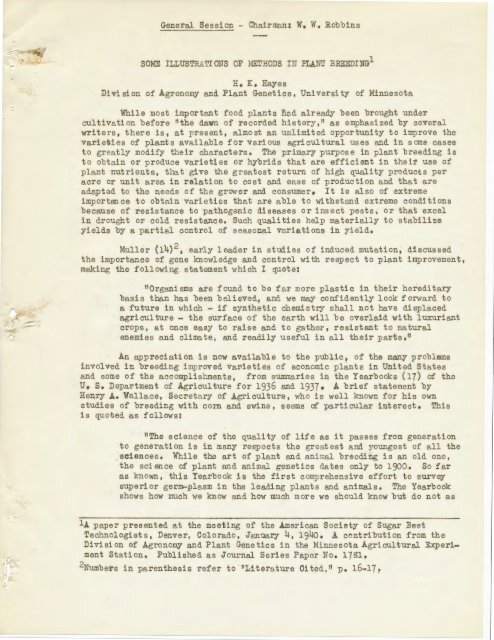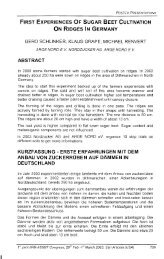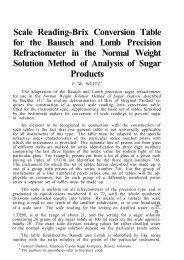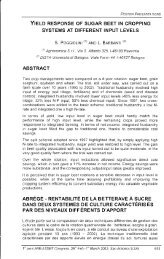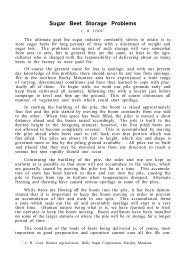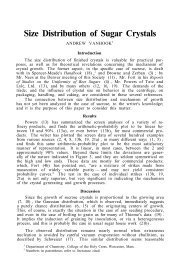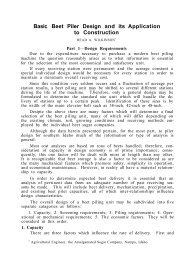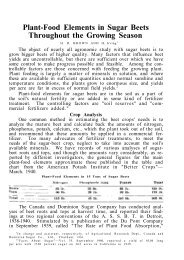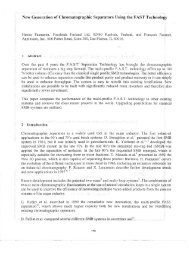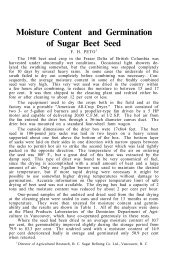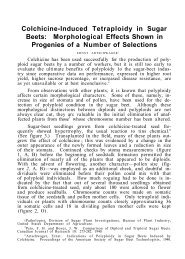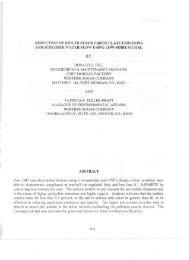Some illustrations of methods in plant breeding - ASSBT Proceedings
Some illustrations of methods in plant breeding - ASSBT Proceedings
Some illustrations of methods in plant breeding - ASSBT Proceedings
You also want an ePaper? Increase the reach of your titles
YUMPU automatically turns print PDFs into web optimized ePapers that Google loves.
General Session- Chairman: W. W. Robb<strong>in</strong>s<br />
SOME ILLUSTRATIONS OF MJ1:THODS HT PLA.Nrr BBEEDING 1<br />
H. K. Hayes<br />
Division <strong>of</strong> Agronomy and Plant Genetics, University <strong>of</strong> M<strong>in</strong>nesota<br />
While most important food <strong>plant</strong>s ho,d already been brought under<br />
cultivation before "the dawn <strong>of</strong> record.ed history, 11 as emphasized by several<br />
writers, there is, at present, almost an unlimited opportunity to improve the<br />
varieties <strong>of</strong> <strong>plant</strong>s available for va.rious agricultural uses and <strong>in</strong> some cases<br />
to greatly modify their characters. The primary purpose <strong>in</strong> <strong>plant</strong> breed<strong>in</strong>g is<br />
to obta<strong>in</strong> or produce varieties or hybrids that are efficient <strong>in</strong> their use <strong>of</strong><br />
<strong>plant</strong> nutrients, that give the greatest return <strong>of</strong> high quality products per<br />
acre or unit area <strong>in</strong> relation to cost and ease <strong>of</strong> production and that are<br />
adapted to the needs <strong>of</strong> the gr~!Ier and consumer. It is also <strong>of</strong> extreme<br />
importen ce to obta<strong>in</strong> varieties the.t are able to withstand extreme conditions<br />
because <strong>of</strong> resistance to pathogenic diseases or <strong>in</strong>sect pests, or that excel<br />
<strong>in</strong> drought or cold resistance. Such qualities help rna terially to stabilize<br />
yields by a partial control <strong>of</strong> seasonal variations <strong>in</strong> yield.<br />
Muller (14) 2 , early leader <strong>in</strong> studies <strong>of</strong> <strong>in</strong>duced mutation, discussed<br />
the importance <strong>of</strong> gene kn.oN1edge and control with respect to <strong>plant</strong> improvement,<br />
mak<strong>in</strong>g the follov.r<strong>in</strong>g statement \IThich I quote:<br />
"Organisms are found to be far more plastic <strong>in</strong> their hereditary<br />
basis than has been believed, and we may confidently look forward to<br />
a future <strong>in</strong> which - if synthetic chemistry shall not have displaced<br />
agriculture- the surface <strong>of</strong> the earth will be overlaid with luxuriant<br />
crops, at once easy to raise and to gather, resistant to natural<br />
enemies and climate, and readily useful <strong>in</strong> all their parts , 11<br />
An appreciation is now available to the public, <strong>of</strong> the many problmms<br />
<strong>in</strong>volved <strong>in</strong> breed<strong>in</strong>g improved varieties <strong>of</strong> economic <strong>plant</strong>s <strong>in</strong> United States<br />
and some <strong>of</strong> the accomplishments, from sum~~ries <strong>in</strong> the Yearbooks (17) <strong>of</strong> the<br />
u.S. Department <strong>of</strong> Agriculture for 1936 and 1937• A brief statement by<br />
Henry A. Wallace, Secretnry <strong>of</strong> Agriculture, -...rho is well known for his own<br />
studies <strong>of</strong> breed<strong>in</strong>g ,.,ith corn and s\..r<strong>in</strong>e, seems <strong>of</strong> particular <strong>in</strong>terest. This<br />
is quoted as follows:<br />
·,<br />
11 The science <strong>of</strong> the quality <strong>of</strong> life as it passes from generation<br />
to generation is <strong>in</strong> many respects the greatest and yow1gest <strong>of</strong> all the<br />
sciences. While the art <strong>of</strong> <strong>plant</strong> and animal breed<strong>in</strong>g is an old one,<br />
the science <strong>of</strong> <strong>plant</strong> and a..rlimal genetics dates only to 1900. So far<br />
as k~own, this Yearbook is the first comprehensive effort to survey<br />
superior germ-plasm <strong>in</strong> the lead<strong>in</strong>g <strong>plant</strong>s and animals. The Yearbook<br />
shows how much vre know and how much more we should know but do not as<br />
lA paper presented at the meet<strong>in</strong>g <strong>of</strong> the American Society <strong>of</strong> Sugar Beet<br />
Technologists, Denver, Colorado, Jenuary 4, 1940. A contribution from the<br />
Division <strong>of</strong> Agronomy and Plant Genetics <strong>in</strong> the M<strong>in</strong>nesota Agricultural Experiment<br />
Station, Published as Journal Series Paper :Ho. 1781,<br />
2Numbers <strong>in</strong> parenthesis refer to 11 Li terature Cited, II p, 16-17,
yet. True, the science <strong>of</strong> genetics is still young and grow<strong>in</strong>g. I<br />
trust that the day \'rill come \'/hen hwnani ty will take as great an <strong>in</strong>ter..o.<br />
est <strong>in</strong> the creation <strong>of</strong> superior forms <strong>of</strong> life as it has taken <strong>in</strong> past<br />
years <strong>in</strong> the perfection <strong>of</strong> superior forms <strong>of</strong> mach<strong>in</strong>ery. In the long<br />
run superior life forms ma.y prove to have a greater pr<strong>of</strong>it for mank<strong>in</strong>d<br />
than mach<strong>in</strong>ery • 11<br />
Standardization <strong>of</strong> Breed<strong>in</strong>g ~ifethods<br />
While ne\'l technics <strong>in</strong> <strong>plant</strong> breed<strong>in</strong>g are be<strong>in</strong>g developed from year to<br />
year, certa<strong>in</strong> standardized <strong>methods</strong> ~~ve been developed for particular categories<br />
<strong>of</strong> crop <strong>plant</strong>s and for specialized problems. These can be illustrated<br />
best, I th<strong>in</strong>k, <strong>in</strong> rela.tion to their application.<br />
There is a close relation bet\'leen <strong>methods</strong> <strong>of</strong> breed<strong>in</strong>g and normal mode<br />
<strong>of</strong> poll<strong>in</strong>ation. Four subdivisions are <strong>of</strong> major importance altho there is no<br />
sharp division between classes.<br />
1. Naturally self poll<strong>in</strong>ated (4% or loss <strong>of</strong> cross poll<strong>in</strong>ation). Barley,<br />
\·Theat, oats, tobacco, potatoes, flax, rice, peas, beans, soybeans, cowpeas.<br />
2. Often cross poll<strong>in</strong>ated (self poll<strong>in</strong>ation ) cross poll.) Cotton, sorghums,<br />
some stra<strong>in</strong>s <strong>of</strong> sweet clover.<br />
3• Naturally cross poll<strong>in</strong>ated.<br />
Maize, rye, clovers, sugar beets, cucurbits, most perennial grasses.<br />
Self sterile <strong>plant</strong>s.<br />
4. Dioecious. Hops, hemp, sp<strong>in</strong>ach, asparagus.<br />
l'l'i th this classification as a background it seems logical to outl<strong>in</strong>e<br />
some standardized <strong>methods</strong> <strong>of</strong> breed<strong>in</strong>g for particular problems <strong>in</strong> relation to<br />
the biology <strong>of</strong> the <strong>plant</strong> and the type <strong>of</strong> improvement soughto Many changes <strong>of</strong><br />
viewpo<strong>in</strong>t have taken place dur<strong>in</strong>g tho 30 years that I have been actively<br />
engaged <strong>in</strong> studies <strong>of</strong> genetics ro1d <strong>plant</strong> breed<strong>in</strong>g. Early <strong>in</strong> this period it was<br />
<strong>of</strong>ten stated that <strong>plant</strong> breed<strong>in</strong>g was largely an art. Vlhile reco&J,i z<strong>in</strong>g the<br />
importance <strong>of</strong> the art I shall try to emphasize the value <strong>of</strong> aknowledge <strong>of</strong><br />
genetics <strong>in</strong> its application to problems <strong>of</strong> crop improvement. About 1915,<br />
Dr. Raymond Pearl stated that the breeder <strong>of</strong> the self-poll<strong>in</strong>ated group <strong>of</strong> <strong>plant</strong>s<br />
used Mendel's Lav.rs as a direct and '"ork<strong>in</strong>g guide. In so do<strong>in</strong>g the first<br />
standa.rdi zed breed<strong>in</strong>g program came to be designated as 11 the pedigree m ethod. 11<br />
It consists <strong>of</strong> mak<strong>in</strong>g a cross between parent l<strong>in</strong>es that differ <strong>in</strong> several<br />
important characters follov..red by selection, dur<strong>in</strong>g the segregat<strong>in</strong>g generations,<br />
for the comb<strong>in</strong>ation <strong>of</strong> characters desired. Many <strong>of</strong> the cha.racters <strong>of</strong> selection<br />
value will be related to yield<strong>in</strong>g ability. There \•rill be other genetic factors<br />
for yielcli,ng ability tha.t can 'be selected by the breeder only through field<br />
trials <strong>of</strong> sufficient numbers, under proper <strong>methods</strong> <strong>of</strong> experimental design, so<br />
t~~t the higher yield<strong>in</strong>g stra<strong>in</strong>s can be selected on the basis <strong>of</strong> their performance.<br />
Cross<strong>in</strong>g Followed by Selection Dur<strong>in</strong>g Segregat<strong>in</strong>g Generations<br />
The breed<strong>in</strong>g program can be summarized as follO\'lS!<br />
The pedigree method<br />
1. Select<strong>in</strong>g the parents with the vie\'l <strong>of</strong> comb<strong>in</strong><strong>in</strong>g; their desirable characters
,------------ --- ---- -------------- ----- ------------------------------------<br />
-3-<br />
<strong>in</strong> a s<strong>in</strong>gle variety.<br />
2. Mak<strong>in</strong>g the cross.<br />
3· Grow<strong>in</strong>g the F 2 to F 5<br />
is possible.<br />
generation <strong>plant</strong>s <strong>in</strong>dividually spaced so that selection<br />
4. Study<strong>in</strong>g the progeny by grm
-4-<br />
It seems unneces sary to empha size the value <strong>of</strong> a kn011rledge <strong>of</strong> the mode<br />
<strong>of</strong> <strong>in</strong>heritance <strong>of</strong> these characters ,as an aid <strong>in</strong> breed<strong>in</strong>g. Such <strong>in</strong>formation aids<br />
the breeder <strong>in</strong> a selection <strong>of</strong> homozygous stra<strong>in</strong>s with the comb<strong>in</strong>ation <strong>of</strong> characters<br />
desired. Cultivated oats, like wheat, are hexaploids and have 3 sets <strong>of</strong><br />
7 pairs <strong>of</strong> chromosomes or 21 haploid chromosomes <strong>in</strong> all. The <strong>in</strong>heritance <strong>of</strong><br />
spikelet disarticulation, while approach<strong>in</strong>g a 3:1 ratio <strong>in</strong>, F2 , gave some F<br />
segregat<strong>in</strong>g l<strong>in</strong>es with wide deviations from this ratio. Similar deviation~ from<br />
expectation have been obta<strong>in</strong>ed <strong>in</strong> wheat. It is important for the breeder to<br />
know that meiotic <strong>in</strong>stability is more frequent <strong>in</strong> some stra<strong>in</strong>s and hybrids <strong>of</strong><br />
wheat and oats than <strong>in</strong> others as emphasized by Powers ( 15) and Myers and<br />
Po1-rers (13) and that selection for regularity <strong>of</strong> behavior leads <strong>in</strong> some cases at<br />
least to greater genetic stabilityo Changes <strong>in</strong> pair<strong>in</strong>g behavior, whereby a<br />
chromosome <strong>of</strong> one set <strong>of</strong> 7 chromosomes may pair <strong>in</strong> crosses with those <strong>of</strong> another<br />
set, expla<strong>in</strong> one <strong>of</strong> the causes at least <strong>of</strong> meiotic <strong>in</strong>stability.<br />
One <strong>of</strong> the important contributions <strong>of</strong> cereal breeders and pathologists<br />
has been t'he development <strong>of</strong> stem rust resh tant varieties <strong>of</strong> wh eat. The<br />
isolation <strong>of</strong> physiollogic races <strong>of</strong> disease organisms is a genetic application.<br />
Over 150 such specialized races <strong>of</strong> stem rust are no,., known. The breed<strong>in</strong>g <strong>of</strong><br />
rust resistant wheat has been greatly simplified by the discovery <strong>of</strong> a type <strong>of</strong><br />
11 mature-<strong>plant</strong> r esis tancell that <strong>in</strong> the Northwest, under field conditions from<br />
head<strong>in</strong>g to maturity, causes certa<strong>in</strong> varieties to be resistant to all physiologic<br />
races <strong>of</strong> black stem rust, even tho they may be susceptible to certa<strong>in</strong> prevalent<br />
races <strong>in</strong> the seedl<strong>in</strong>g stages.<br />
A brief history <strong>of</strong> the d,evelopment <strong>of</strong> Thatcher wheat, <strong>in</strong>troduced <strong>in</strong> 1934<br />
by the M<strong>in</strong>nesota Agricultural Experiment Station, may 'be <strong>of</strong> <strong>in</strong>terest (Hayes and<br />
ot0ers) (9). It resulted from comb<strong>in</strong>ed studies <strong>of</strong> <strong>plant</strong> breeders, <strong>plant</strong><br />
pathologists and ce~eal chemists. Dur<strong>in</strong>g the breed<strong>in</strong>g program many varieties<br />
and hybrids <strong>of</strong> wheat 1vere grovm under rust epidemic conditions <strong>in</strong> a rust nursery<br />
us<strong>in</strong>g prevalent races <strong>of</strong> the rust organism~ Marquis was crossed with a stem<br />
rust resistant durum 1.vhen.t <strong>in</strong> 1915c From this cross three selections were<br />
obta<strong>in</strong>ed that resembled common wh Gat and that were resistant to stem rust under<br />
field, conditions. In 1918, Kanred ':~<strong>in</strong>ter wheat, a variety immune to many races<br />
<strong>of</strong> stem rust but susceptible to others, was crossed. with Harq_uis and from this<br />
cross stra<strong>in</strong>s were selected that comb<strong>in</strong>ed the immunity <strong>of</strong> Kanred to certa<strong>in</strong><br />
races <strong>of</strong> stem rust "ri th the spr<strong>in</strong>g wheat habit <strong>of</strong> Marquis • A cross between<br />
selections from these two crosses was made <strong>in</strong> 1921, i.e. a selection <strong>of</strong><br />
Marquis x Iumillo was crossed with a selection from ~~rq~is x Kanredo Thatcher,<br />
selected from this double cross, comb<strong>in</strong>es the desirable mill<strong>in</strong>g and bak<strong>in</strong>g<br />
~ualities <strong>of</strong> Mar~uis, with the immunity <strong>of</strong> Kanred to certa<strong>in</strong> stem rust races<br />
and with resistance to rnany races <strong>in</strong> the mature <strong>plant</strong> stage from head<strong>in</strong>g to<br />
maturity obta<strong>in</strong>ed from the Iumillo durum parent.<br />
l3efore <strong>in</strong>troduc<strong>in</strong>g Tha.toher it was tested extensively under stem rust<br />
epidemic conditions a.nd equally careful studies were made <strong>of</strong> yield<strong>in</strong>g e:bility<br />
and mill<strong>in</strong>g and bo,k:<strong>in</strong>g q_uali ty. Yields <strong>in</strong> bushels per acre at the Crookston and<br />
Morris branch experiment stations from 1929 to 1938 1 <strong>in</strong>clusive, and <strong>in</strong> the<br />
years <strong>of</strong> severe stem rust epidemics <strong>in</strong> 1935, 1937 and 1938 show clearly the<br />
value <strong>of</strong> stem rust resistance.<br />
The yield <strong>of</strong> Thatcher and <strong>of</strong> other varieties given <strong>in</strong> table 1 shO\-JS<br />
clearly the value <strong>of</strong> stem rust resistance <strong>in</strong> 1935, 1937 and 1938 ,.,hen there<br />
were severe epidemics •
,...5-<br />
Table 1. Yielcls <strong>in</strong> bushels per acre <strong>of</strong> Thatcher and <strong>of</strong> other<br />
standard varieties.<br />
192~-38 ' 19)5, 1937, 1238lemen t <strong>of</strong> the recurrent parent<br />
<strong>in</strong> the lst, 2nd, 3rd, etc., generations <strong>of</strong> backcross<strong>in</strong>g accord<strong>in</strong>g to the progression<br />
1/2, 3/1+, 7/8, etc. The backcross method will be illustrated <strong>in</strong><br />
relation to \vheat breed<strong>in</strong>g. Its applicability is illustrated as follows:<br />
Backcross<strong>in</strong>g as a method <strong>of</strong> breed.<strong>in</strong>~<br />
1. Selection <strong>of</strong> parentn.<br />
A. A variety with d.esirable characters but lack<strong>in</strong>g one or t1.-ro characters<br />
that are dependent upon only a few gen
History <strong>of</strong> backcross (Thatcher x Hope). x Tl:1~::ttcher<br />
Year<br />
1930<br />
1930-31<br />
1931<br />
1932-37<br />
Leaf rust<br />
Stem "<br />
Place<br />
Field<br />
Greenhouse<br />
Field<br />
Field<br />
epide-m-,.i_c_s-only ln 1932,<br />
u each year.<br />
'35<br />
Plan<br />
Orig<strong>in</strong>al Cross<br />
1st -oackcro s s<br />
2nd 11<br />
Pedigree selection<br />
Yield <strong>in</strong> bushels per acre, test weight, and jh_eaf rust reaction are<br />
given <strong>in</strong> table 2 from trials m;:tde <strong>in</strong> 1938 '.V"hen there was a severe rust epidemic<br />
<strong>in</strong> the Northvrest spr<strong>in</strong>g ,,rheat area.<br />
Table 2e<br />
Yield <strong>in</strong> bushels per acre and test weight,rod-row replicated trials<br />
University Farm, 193g~ Leaf rust reaction <strong>in</strong> rod rows (Agron.) and<br />
<strong>in</strong> the rust Nursery (R.N.).<br />
Yield<br />
Test·--<br />
Rust Percent<br />
Variety buo '!tlt 0 Leaf Stem<br />
-~gro~. R,N o Agron. R.N.<br />
Thatcher 18 lj.7 70 80 T 3<br />
B.,C,, II-31-2 31 55 2 T T T<br />
II<br />
-6 30 54 T 5 T T<br />
It<br />
-14 32 5l.~ 3 T T T<br />
Briggs (2,3) <strong>in</strong> California, has used the backcross method extensively<br />
<strong>in</strong> breed<strong>in</strong>g improved var ie ties <strong>of</strong> '"heat. He uses desirable adapted varieties<br />
<strong>of</strong> wheat as one parent and has add.ed bunt resistance by backcross<strong>in</strong>g and<br />
selection.<br />
The feN· <strong>illustrations</strong> that I ht1ve given sh0\'1 how genetic pr<strong>in</strong>ciples have<br />
been adapted rather generally by the <strong>plant</strong> breeder ipterested <strong>in</strong> small gra<strong>in</strong>s.<br />
Similar ill us tra.tions could be gi von by the score for other self-poll<strong>in</strong>ated<br />
crop <strong>plant</strong>s.<br />
Deyel ?pmen t <strong>of</strong> Standardized Breed<strong>in</strong>g Meth._ods '~i th Corn<br />
'\'lith corn, the most important farm crop gro\m <strong>in</strong> United States, the<br />
breed<strong>in</strong>g <strong>of</strong> improved hybrid varieties has had the most far-reach<strong>in</strong>g effect <strong>of</strong><br />
any work <strong>in</strong> crop improvement <strong>in</strong> the present century3 Standardization <strong>of</strong> breed<strong>in</strong>g<br />
<strong>methods</strong>, based on genetic pr<strong>in</strong>ciples, has played. a large part <strong>in</strong> the success<br />
that has been atta<strong>in</strong>edo The studies <strong>of</strong> East, B.t the Connecticut Experiment<br />
Station, and <strong>of</strong> Shull a.t Cold Spr<strong>in</strong>g Harbor, were started <strong>in</strong> 1905. Shull <strong>in</strong><br />
1909 suggested a method <strong>of</strong> us<strong>in</strong>g crosses bet1treen <strong>in</strong>bred l<strong>in</strong>es, It \V'as my good<br />
fortune to \-.rork under East's direction at the Connecticut Agricultural Experiment<br />
Station start<strong>in</strong>g <strong>in</strong> 1909. A statement <strong>of</strong> his that seemed to me to be<br />
very significant is quoted as I remember it. He said, 11 I started a study <strong>of</strong> the<br />
physiology <strong>of</strong> <strong>in</strong>heritance <strong>in</strong> maize, believ<strong>in</strong>g that a knm'/ledge <strong>of</strong> pr<strong>in</strong>ciples<br />
was necessary <strong>in</strong> the formulation <strong>of</strong> a logicB.l method <strong>of</strong> breed<strong>in</strong>g • 11 A bullet<strong>in</strong><br />
published <strong>in</strong> 1912 summarized the effects <strong>of</strong> self fertilization <strong>in</strong> corn. Hybrid<br />
vigor was discussed <strong>in</strong> relation to evolution and <strong>plant</strong> breed<strong>in</strong>g. The<br />
follow<strong>in</strong>g statements were taken from this bullet<strong>in</strong>.
Effects <strong>of</strong> self fertilization <strong>in</strong> corn<br />
(After East & HayesT(5<br />
-7-<br />
lo Loss <strong>of</strong> vegetative vigor ha.s follo'\
-<br />
-8-<br />
when crossed with other <strong>in</strong>ored l<strong>in</strong>es or with a commercial variety seem to<br />
have "better comb<strong>in</strong><strong>in</strong>g a.oili ty, that is, give greater hyorid vigor, than other<br />
<strong>in</strong>ored l<strong>in</strong>es v,rhich <strong>in</strong> themselves seem equally desirable, and there seems to<br />
be a gro\.,r<strong>in</strong>g body <strong>of</strong> evidence that comb<strong>in</strong><strong>in</strong>g ability is an <strong>in</strong>herited character.<br />
In one experiment with 110 <strong>in</strong>bred l<strong>in</strong>es <strong>of</strong> corn, careful studies '"ere made <strong>of</strong><br />
14 characters <strong>of</strong> the <strong>in</strong>breds <strong>in</strong> relation to the com'b<strong>in</strong><strong>in</strong>g a.bili ty <strong>in</strong> <strong>in</strong>bredvariety<br />
crosses us<strong>in</strong>g the open-poll<strong>in</strong>ated variety, H<strong>in</strong>n. 13, as one parent <strong>in</strong><br />
each cross. Twelve <strong>of</strong> the 14 characters <strong>of</strong> the <strong>in</strong>bred l<strong>in</strong>es were positively<br />
1:1.nd significantly correlated '~Ti th yield<strong>in</strong>g ability <strong>in</strong> the <strong>in</strong>bred-variety<br />
cronses. Table 3 lists the characters <strong>of</strong> the <strong>in</strong>bred l<strong>in</strong>es used <strong>in</strong> the study<br />
and presents correlation coefficients for all possible relationships <strong>in</strong>clud<strong>in</strong>g<br />
correlations between 14 characters <strong>of</strong> the <strong>in</strong>brods with the yield <strong>of</strong> <strong>in</strong>bredvariety<br />
crosses designated ns 15 <strong>in</strong> the table.<br />
Table 3o Total correlations between 12 chn.racters <strong>of</strong> the 110 <strong>in</strong>breds and yield<strong>in</strong>g<br />
ability <strong>of</strong> <strong>in</strong>bred variety crosses (Hayes<br />
1<br />
and Johnson)(8)<br />
~~mr.r3 J4 r5-, : r--~-·-g _9_i__ 10 13 14 15<br />
-1 -·fl·5118e.6os "8 9·, 5P" 193. o51+b§'"lr"ff083l!O;o3741 0,2230 o.,073l~Oo059l Oo4742<br />
2 --- r·756'0.4419 .4817P.4294b·3959 0.2588!0.185510.3568 Oe2549l 0.0812 0.2717<br />
3 · --- --- .4324 •5388j().50 21J ol.a3310.352210,3317 0 . 2201 Oel512f-0.0074 o.4110<br />
4 --- I--- --- po~·95~~4417Po4797 0.3959 Oo289310.1S47 o.a:o4o 0.0815 0.2889<br />
5 II--- ~--- 1 --- .7623b.5095io~60l'J 1 o.4o52 1 o.2o8~ o.1Ll84 0.0352 o.4486<br />
6 --- ---- I --- 1<br />
--- Pa55l+510e742lti0e389610.2R9 0.1947 Oo0320 0.5430<br />
7 ; i i --- 1 --- I --- II o ·5355 lo .2384 o .267 o . 2065 o .1549 o .4069<br />
g i I I ---~ --- 1: --- 1 --- 10 o2559j 0 o2245! 0 o2025 0.0683 0.4463<br />
9 1 j ---, : --- ---~O.l990~0o0029~0.0342 Ool902<br />
10 I I --- I I I --- --- I 0 ·3451 0 ·3202 0 . 21-)66<br />
13 I I --- I i II --- I --- 0 . 61+03 0 . 2474<br />
14 ----1 I ,. ---l I I --- I ---, 0.2768<br />
15 --- ' - I I ---I j_ ___L_ ---. -_-_-__....1__-__<br />
-_--+----'----<br />
Significant value <strong>of</strong> r :for P <strong>of</strong> .. 05 :: 0 .188<br />
Significant value <strong>of</strong> r for P <strong>of</strong> .01 -= 0 .2l+6<br />
*Key to<br />
1<br />
2<br />
a<br />
characters:<br />
Inbred date silked<br />
Inbred <strong>plant</strong> height<br />
Inbred ear height<br />
Inbred leaf area<br />
5 Inbred pull<strong>in</strong>g resistance<br />
6 Inbred root volume<br />
7 Inbred stalk diameter<br />
8 Inbred total brace roots<br />
9 Inbred tassel <strong>in</strong>dex<br />
10 Inbred pollen yield<br />
1') Inbrod yield <strong>in</strong>dex<br />
14 Inbred ea.r length<br />
15 Inbred-variety cross yield<br />
From this study it was found th.1. t t he multiple correlation b e h1een<br />
12 <strong>of</strong> these characters <strong>in</strong> the <strong>in</strong>breds and yield <strong>in</strong> the <strong>in</strong>bred-variety crosses<br />
was .67. Date <strong>of</strong>; silk<strong>in</strong>g was held constant and. a partial multiple correlation<br />
coefficient was found where the multiple correlation R, hold<strong>in</strong>g constant date<br />
<strong>of</strong> silk<strong>in</strong>g, is obt[·dned from the follow<strong>in</strong>g formu..lae :<br />
1- R2 15.2,3,4,s,6.7.e.9,1o,ll,l2\11<br />
l-R2<br />
= 15.1------12<br />
l-R.:..l5 .1 ..<br />
The computed value <strong>of</strong> R <strong>in</strong> this case was 0.,5310 •
-9-<br />
These results show t~tt the characters <strong>of</strong> <strong>in</strong>bred l<strong>in</strong>es which are<br />
responsible for their relative vigor <strong>of</strong> grO\•rth are also to a considera.ble<br />
extent responsible for the comb<strong>in</strong><strong>in</strong>g ability <strong>of</strong> the <strong>in</strong>breds themselves, as measured<br />
by yield <strong>in</strong> <strong>in</strong>bred-variety crosses.<br />
The mendelian explanation <strong>of</strong> hybrid vigor is essential <strong>in</strong> an understand<strong>in</strong>g<br />
<strong>of</strong> breedi:n,g <strong>methods</strong> with cross-poll<strong>in</strong>ated crop <strong>plant</strong>s. If thee xplanation<br />
is a correct one it would seem possible to breed improved <strong>in</strong>bred l<strong>in</strong>es<br />
that approach homozygosity and that approach the F1 <strong>in</strong> vigor <strong>of</strong> grovrth. With<br />
different cross-poll<strong>in</strong>ated <strong>plant</strong>s the difficulties 'trould seem to be <strong>in</strong> direct<br />
relation to the number <strong>of</strong> grov1th factors <strong>in</strong>volved, i .eo, the extent <strong>of</strong><br />
heterozygosity. Throughout the corn belt most and perhaps all corn breeders are<br />
endeavor<strong>in</strong>g to obta<strong>in</strong> more vigorous <strong>in</strong>bred l<strong>in</strong>es. The breed<strong>in</strong>g <strong>methods</strong> available<br />
are not greatly d.ifferent than those that have been illustrated with<br />
small gra<strong>in</strong>s but m~~ be repeated here for corn. Before discuss<strong>in</strong>g the breed<strong>in</strong>g<br />
<strong>of</strong> improved <strong>in</strong>breds, the commercial value <strong>of</strong> three-way and double crosses will<br />
be illustrated.<br />
Commercial Value <strong>of</strong> Three-way and Double Crosses<br />
Two types <strong>of</strong> crosses are be<strong>in</strong>g utilized by the commercial grower, the<br />
three-way and double cross. A three-way eros s utilizes three <strong>in</strong>bred l<strong>in</strong>es<br />
and a double cross is made us<strong>in</strong>g four <strong>in</strong>b;red.s. M<strong>in</strong>hybrid 301 illustrates a<br />
three-way cross that has been grown extensively <strong>in</strong> southern M<strong>in</strong>nesota. M<strong>in</strong>hybrid<br />
1~03, a double cross, also has been grown extensively.<br />
The double cross plan is ill us tra.t ed for M<strong>in</strong>hybrid 4o3.<br />
Inbred l<strong>in</strong>es 11 14 371+ 375<br />
S<strong>in</strong>gle crosses<br />
~ .// ~/<br />
( llxl4) (37ltx375)<br />
......______ -------··--~<br />
Double cross ( llxi4} ·-( 374x375)<br />
Comparative yields <strong>of</strong> M<strong>in</strong>hybrids 301 and 1+03 and commercial varieties<br />
illustrate the value <strong>of</strong> the met>.od. Ability to ,.,.ithstand lodg<strong>in</strong>g and resistance<br />
to diseases such as smut and ear and stalk rots are some <strong>of</strong> the reasons why<br />
hybrids are more desirable than commercial varieties . The comparative yields<br />
given <strong>in</strong> tables 4 and 5 <strong>in</strong>dicate r ather clearly the value <strong>of</strong> hybrids to the<br />
commercial g rower. The yields <strong>in</strong> table 4 r ep resent r esults from demonstration<br />
trials where the hybrids woro <strong>plant</strong>ed. <strong>in</strong> strip plots <strong>in</strong> commercial fieldso<br />
The results <strong>in</strong> table 5 are from randomized block trials, replicated five times<br />
at each location. l\furdock \'las used ~1.s a standard open-poll<strong>in</strong>ated variety. All<br />
tests are on the basis <strong>of</strong> bushels per acre, 14 percent moisture basis.<br />
Table 4. Yi eld <strong>in</strong> bushels per acre <strong>of</strong> lvi<strong>in</strong>hybrids 301 and 403 compared with<br />
f a rm v ari e ties •<br />
No • <strong>of</strong> trial s<br />
Yield <strong>of</strong> hybrid.<br />
Yi eld <strong>of</strong> f arm variety<br />
Increase - bushels<br />
M<strong>in</strong>hybrij_j.Q_l ___ _<br />
454<br />
54.6<br />
46.6<br />
s.o
Table 5· Yield <strong>in</strong> bushels per acre <strong>of</strong> M<strong>in</strong>hybrids 301, 403 and Murdock,<br />
1937-38.<br />
Location (county)<br />
Brown-Cottonwood<br />
Rock<br />
'rtlaseca-Fa.ri baul t<br />
Fillmore-Houston<br />
Average<br />
B·u. <strong>in</strong>crease over Nu.rdock<br />
-10-<br />
M<strong>in</strong>hybrid<br />
------·--·-----r;:_--·- 301<br />
oOol<br />
66.2<br />
63.0<br />
68.8<br />
64o5<br />
10.7<br />
M<strong>in</strong>hybrid<br />
4o3<br />
Nurd.ock<br />
-«--:::----·<br />
b2 ·5 50.2<br />
70.6 54.1<br />
66o2 53ol<br />
72.4 57·3<br />
67.9<br />
14.2<br />
53·7<br />
The data given <strong>in</strong> tables 4 and 5 shO\'V clearly the vnlue <strong>of</strong> these two<br />
hybrids <strong>in</strong> comparison with open-poll<strong>in</strong>ated varieties thtl.t are similar to these<br />
hybrids <strong>in</strong> dnte <strong>of</strong> maturity.<br />
~reed<strong>in</strong>g Impro~ed Inbred L<strong>in</strong>es <strong>of</strong> Corn<br />
Two <strong>methods</strong> <strong>of</strong> breed<strong>in</strong>g improved <strong>in</strong>bred l<strong>in</strong>es <strong>of</strong> corn are be<strong>in</strong>g used<br />
rather extensively <strong>in</strong> the Corn Belt. These are backcross<strong>in</strong>g and convergent<br />
improvement •<br />
An undesirable ch2.racter <strong>of</strong> the three-way cross, Jvi<strong>in</strong>hybrid 301, is the<br />
suscep ti bili ty to smut <strong>of</strong> tho <strong>in</strong>bred Bl6l~. This <strong>in</strong>bred has been changed by<br />
backcross<strong>in</strong>g. The method may be illustrn.ted as follo'''s:<br />
Impr~vement <strong>of</strong> Bl61~ by _..E.:·wkcro~_r,<strong>in</strong>g with particular reference to smut resist~ce<br />
Early . <strong>in</strong>bre~-' _037<br />
Smut susceptible<br />
Smut resistance<br />
Method<br />
lo (Bl64 X 37) X Bl64<br />
2. [(Bl64 X 37) x Bl6lQ X Bl64<br />
Selection <strong>in</strong> 1 and 2 for smut resistance.<br />
3• Self poll<strong>in</strong>ation and selection (2 years).<br />
4. Select a desirable smut resistant l<strong>in</strong>e resembl<strong>in</strong>g Bl64,<br />
In a field trial <strong>in</strong> 1938 and 1939 several such l<strong>in</strong>es \'lere obta<strong>in</strong>ed that<br />
were highly smut resistant <strong>in</strong> comparison with Bl61~-.<br />
Convergent improvement, first svggested by Hichey ( 16) <strong>in</strong> 1927 ( eq_uivalent<br />
to double back:cross<strong>in</strong>g), is a method <strong>of</strong> improv<strong>in</strong>g each <strong>of</strong> hro <strong>in</strong>breds<br />
v1i thout modify<strong>in</strong>g their comb<strong>in</strong><strong>in</strong>g ability i,rhen crossed together. It may be<br />
illustrated with hro <strong>of</strong> the <strong>in</strong>bred l<strong>in</strong>es used <strong>in</strong> M<strong>in</strong>hybrid 4o3. <strong>Some</strong> <strong>of</strong> the<br />
differential characters <strong>of</strong> the <strong>in</strong>bred l<strong>in</strong>es 11 and 375 are given here.<br />
Characters <strong>of</strong> the parental <strong>in</strong>breds<br />
11<br />
Smut susceptible<br />
Large seed*<br />
Premature germ<strong>in</strong>ation<br />
Fair root system<br />
37~<br />
Smut resistant*<br />
Small seed<br />
Good q_uality see
- -<br />
··11-<br />
The <strong>methods</strong> follo~,red<br />
are given <strong>in</strong> outl<strong>in</strong>e form.<br />
Convergent improvement<br />
lst backcross<br />
2nd 11<br />
3rd It<br />
(llx375) 375<br />
(llx375) 3752<br />
( llx375) 3753<br />
Select for seed sizeo<br />
( llx375)<br />
(llx375)<br />
(llx375)<br />
Select for sn,ut resistance.<br />
" 11 good. seed q_uali ty.<br />
t1 11 strong root system.<br />
4. Self poll<strong>in</strong>ation and selection for characters desired ( 2 years) •<br />
The <strong>in</strong>bred parents 11 and 14 were improved <strong>in</strong> stand<strong>in</strong>g ability and <strong>in</strong><br />
smut resistance. Inbred l<strong>in</strong>e 11 \-.ras improved <strong>in</strong> q_uali ty <strong>of</strong> seed while <strong>in</strong>bred<br />
14 was improved <strong>in</strong> seed size and <strong>in</strong> ear length. Inbreds 374 and 375 were<br />
improved <strong>in</strong> ear type.<br />
Another method used extensively <strong>in</strong> M<strong>in</strong>nesota to breed. improved. <strong>in</strong>bred.s<br />
is the so-called. pedigree method illustrated as follows, \oJ:bJ.ch has been<br />
described by Hayes ~~d. Johnson (3).<br />
Breed<strong>in</strong>g improved <strong>in</strong>bred,s by the pedigree method<br />
1. Select <strong>in</strong>bred.s that excel <strong>in</strong> the characters desired.<br />
ex., one parent resist~~t to smut, tne other to lodg<strong>in</strong>g.<br />
2. Make several crosses <strong>of</strong> unrelated <strong>in</strong>breds.<br />
3• Cont<strong>in</strong>ue selection <strong>in</strong> self-poll<strong>in</strong>ated l<strong>in</strong>es for smut resistance, strength<br />
<strong>of</strong> stalk and other desirable cha.ra cters for 5 or 6 years.<br />
4. Comb<strong>in</strong>e the be~ter l<strong>in</strong>es us<strong>in</strong>g crosses between l<strong>in</strong>es <strong>of</strong> different genetic<br />
orig<strong>in</strong>.<br />
lntroduced <strong>in</strong>breds that excelled <strong>in</strong> strength <strong>of</strong> stalk were used. as one<br />
parent <strong>of</strong> several <strong>of</strong> the orig<strong>in</strong>al crosses. As st~:md<strong>in</strong>g ability '"as d.iffi cult to<br />
select <strong>in</strong> commercial varieties, later mat'-lr<strong>in</strong>g <strong>in</strong>breds \dth good stanct<strong>in</strong>g ability<br />
were <strong>in</strong>troduced from other breeders.<br />
These <strong>in</strong>troduced <strong>in</strong>breds were crossed \vith eP>.rly matur<strong>in</strong>g <strong>in</strong>breds<br />
selected <strong>in</strong> M<strong>in</strong>nesota, and selection was practiced dur<strong>in</strong>g the segregat<strong>in</strong>g generations.<br />
<strong>Some</strong> characters <strong>of</strong> selection value tha t have been used <strong>in</strong> mak<strong>in</strong>g selections<br />
from F 3 to F6 are <strong>of</strong> <strong>in</strong>terest.<br />
<strong>Some</strong> characters <strong>of</strong> selection value<br />
1. Length <strong>of</strong> ear and ear production.<br />
2. Period <strong>of</strong> maturity.<br />
3· Vigor <strong>of</strong> <strong>plant</strong>.<br />
4. Well developed root system.<br />
5· Smut resistance.<br />
After obta<strong>in</strong><strong>in</strong>g the best possible <strong>in</strong>breds (110 '\'Jere selected at University<br />
Farm and. about the same number were available from the 11faseca studies) the<br />
follov-r<strong>in</strong>g <strong>methods</strong> have been used <strong>in</strong> further work •
-12-<br />
~ct<strong>in</strong>g crosses from <strong>in</strong>bred l<strong>in</strong>es avcdlable<br />
1. Determ<strong>in</strong>e best comb<strong>in</strong>ers <strong>in</strong> <strong>in</strong>bred-.varie ty crosses.<br />
2. Make a~l possible s<strong>in</strong>gle crosses between unrelated l<strong>in</strong>es.<br />
3• Predict yield <strong>of</strong> double crosses.<br />
4. Me,ke yield trials <strong>of</strong> actual double crosses.<br />
Jenk<strong>in</strong>s (10) compared various methocls <strong>of</strong> test<strong>in</strong>g the comb<strong>in</strong><strong>in</strong>g ability<br />
<strong>of</strong> <strong>in</strong>bred l<strong>in</strong>es <strong>in</strong> double crosses us<strong>in</strong>g s<strong>in</strong>gle crosses as one method <strong>of</strong> pre-.<br />
diet<strong>in</strong>g the yield<strong>in</strong>,_:,. ability <strong>of</strong> double crosses. Doxtater and Jor.nson ( 4) made<br />
a further study <strong>of</strong> s<strong>in</strong>gle crosses as a means <strong>of</strong> predict<strong>in</strong>g the yield <strong>of</strong> a<br />
particular double cross. The follo\v<strong>in</strong>g data is taken from the 1J·l0rk <strong>of</strong><br />
Anderson (1) and shows how s<strong>in</strong>gle crosses are used to make such a prediction.<br />
The yield <strong>of</strong> a particular double cross may be determ<strong>in</strong>ed lifi th accuracy from<br />
the average yield <strong>of</strong> the four s<strong>in</strong>gle crosses not used as parents <strong>in</strong> the double<br />
cross. From any four <strong>in</strong>bred l<strong>in</strong>es six s<strong>in</strong>gle crosses can be made and three<br />
different double crosses. One <strong>of</strong> these three double crosses frequently yields<br />
more than the other twoo<br />
The <strong>in</strong>breds that yield viell <strong>in</strong> <strong>in</strong>bred..-variety crosses may be tested <strong>in</strong><br />
s<strong>in</strong>gle crosses and their yield<strong>in</strong>g ability <strong>in</strong> double crosses predicted, as<br />
illustrated from data presented by Anderson.<br />
Ill!ethod <strong>of</strong> predict<strong>in</strong>g double cross yields from s<strong>in</strong>gle eros s data<br />
(2]x24) x . (26x27) ( 2~x26) x (24x27)<br />
( 23x26) 62 .. 6 (2Jx24) 41.7<br />
(23x27) 70.8 (23x27) 70.8<br />
(24x26) 65o6 (26x24) 65.6<br />
( 24x27) 72ol ( 26x27) 64.2<br />
Av. 67 .. 8 Av. E"i5. 6<br />
( 23x27) x (24x26)<br />
(23x24) 41.7<br />
( 23x26) 62.6<br />
(24x27) 72.1<br />
(26x27) 64.2<br />
Av. 60.2<br />
A comparison <strong>of</strong> actual and predicted yields <strong>of</strong> double crosses by<br />
Anderson is given to show the value <strong>of</strong> the method.<br />
... _<br />
A comparison <strong>of</strong> actual and predicted yields (after And erson)<br />
L<strong>in</strong>es comb<strong>in</strong>ed<br />
23,24,26,27 .<br />
(23x24) x (26x27)<br />
( 23x26) ·X ( 24x27)<br />
(23x27) x (24x26)<br />
23,24,26,28 .<br />
( 23x24) x ( 26x28)<br />
(23x26) X (24x28)<br />
(23x28) x (24x26)<br />
Bu. p er A.<br />
Actual PreQicted<br />
68.8<br />
62.4<br />
62.0<br />
67 .s<br />
ED .6<br />
6o.2<br />
(cont<strong>in</strong>ued)<br />
I
23,24,27,28<br />
( 23x24) x ( 27x28)<br />
(23x27) x (24x28)<br />
(23x28) x (24x27)<br />
Diff. for signif.<br />
71.1<br />
58.1<br />
58.0<br />
5-26<br />
69.2<br />
59 .. 4<br />
6o.4<br />
3o41<br />
I'<br />
Inbred l<strong>in</strong>es selected at "Taseca and University Farm vtere comb<strong>in</strong>ed <strong>in</strong><br />
s<strong>in</strong>gle crosses us<strong>in</strong>g unrelated l<strong>in</strong>es. The <strong>in</strong>breds used <strong>in</strong> one cross illustrate<br />
the method without the necessity <strong>of</strong> detailed description. It \\I' ill be noted<br />
that <strong>in</strong>breds A96, Al63, All6 and Al31 \'/ere selected from crosses between<br />
<strong>in</strong>breds (64xH), (43x47), (49x9) and (11-28 x 15-28), respectively. After<br />
cross<strong>in</strong>g, self poll<strong>in</strong>ation and selection was practiced six years before<br />
<strong>in</strong>breds were selected for use <strong>in</strong> crosses. A96, Al63, All6, Al31 and other <strong>in</strong>b<br />
reds used as parents <strong>of</strong> double crosses >'lere first tested for comb<strong>in</strong><strong>in</strong>g ability<br />
end only good comb<strong>in</strong>ers i'lere selected.<br />
Genetic diversity <strong>of</strong> <strong>in</strong>breds<br />
Orig<strong>in</strong>al parent <strong>in</strong>breds<br />
64<br />
H (Reid's)<br />
43, 47, 49, 11-28<br />
9<br />
15-28<br />
Inbreds selected<br />
A 96<br />
A163<br />
All6<br />
.A.l31<br />
Source<br />
N .T:l. Dent<br />
From Holbert, Ill.<br />
Four lv1<strong>in</strong>n. #13 <strong>in</strong>breds<br />
~lis. Golden Glow<br />
Rustler<br />
Orig;<strong>in</strong><br />
64 X H<br />
43 X 47<br />
49 X 9<br />
11-28 X 15-28<br />
The yield<strong>in</strong>g abili~ <strong>in</strong> a double cross <strong>in</strong> bushels per acre on a 14<br />
percent moisture basis and the moisture percentage (% M) at harvest, used to<br />
show relative time <strong>of</strong> maturity, is illustrated <strong>in</strong> the follo\r<strong>in</strong>g sum..111ary for<br />
the double cross (A96 x Al63) x (AJ.l6 x Al31).<br />
Method <strong>of</strong> Eredict<strong>in</strong>g yield and actual r esults<br />
Av. yields 4 stations, 3 replice.ti ons per station, 1938<br />
59.1 bu. 47 .,0 bu.<br />
(A96x.ln63)<br />
(All6xA131)<br />
Cro s s :Bu.<br />
---.--<br />
% M.<br />
A96 x All6 57.6 20.5<br />
II<br />
X Al31 58.7 22.0<br />
Al63 X All6 65·3 20.4<br />
II<br />
X Al31 68.2 22.5<br />
Av. b2:5 21.4<br />
M<strong>in</strong>hybrid 4ol 6o.o 24.2<br />
ll<br />
4o2 54·3 21.3
-14-<br />
From this summEtry \ve conclude that the double eros s (A96 x Al63) x<br />
(All6 x Al31) may be erpected to yield as much or more than the later matur<strong>in</strong>g<br />
hybrid, 1-;I<strong>in</strong>hybrid l:J.Ol, and mature as early as N<strong>in</strong>hybri d 402.<br />
;<br />
Four double crosses that were tested <strong>in</strong> southern M<strong>in</strong>nesota <strong>in</strong> 1938 and<br />
1939 illustrate many other comparisons that have been made <strong>in</strong> recent years.<br />
Yield <strong>in</strong> bushels per a ere, 14% moisture basis, for predicted doubles gro\-m <strong>in</strong><br />
1938, yield <strong>in</strong> bushels per acre from actual doubles gro'l'm <strong>in</strong> 1939, and moisture<br />
percentage at harvest is given <strong>in</strong> table 6~ The results given are an average <strong>of</strong><br />
trials <strong>in</strong> three or four locations <strong>in</strong> randomized blocks with three replications<br />
per location.<br />
Table 6. Predicted yield <strong>of</strong> double crosses <strong>in</strong> 1938 and actual yielc1 1939,<br />
compared \'lith standards, lfi<strong>in</strong>hybrids 4ol and 4o3.<br />
Yield bu.* Moisture %*<br />
Dou·ole Cross 19~8 12:29 xv:- 19:28 1939 Av.<br />
(42xl44) x (57x92) 72.6 77·3 75-0 28.6 29..4 29.0<br />
(134xl44) x ( 57x92) 80.7 82.9 81.8 29.6 28.4 29.0<br />
(l22xl34) x (57xl44) 80.2 83.0 81.6 30.8 27.0 28.9<br />
(134x375) x (l22x30) 83.1 86.4 84.8 35·8 33-2 34.5<br />
I'-l<strong>in</strong>hybrid 4ol 62.5 59·7 61.1 28.8 27·3 28.1<br />
" 4o3 7::2.4 11.8 72-6 Jlo6 32·3 32.0<br />
*1938 ;)ri eld and moisture predicted from resu~ ts from F1 crosse so<br />
1938 yields and moisture obta<strong>in</strong>ed <strong>in</strong> regular tests <strong>of</strong> these double crosses.<br />
These results illustrate the many cases ~vhere prediction <strong>of</strong> the yield<strong>in</strong>g<br />
ability <strong>of</strong> double crosses from yields <strong>of</strong> s<strong>in</strong>gles may be used. This greatly<br />
simplifies the test<strong>in</strong>g <strong>of</strong> many double cross combilli~tions for the predicted<br />
yields <strong>of</strong> over one million double crosses can be obta<strong>in</strong>ed from test<strong>in</strong>g 1770<br />
s<strong>in</strong>gle crosses, that <strong>in</strong> turn can be obta<strong>in</strong>ed from all possible comb<strong>in</strong>ations<br />
between only 6o <strong>in</strong>bred l<strong>in</strong>es.<br />
A study <strong>of</strong> F1 crosses bet1nreen the <strong>in</strong>breds available has sho\m the<br />
importance <strong>of</strong> genetic diversity <strong>of</strong> <strong>in</strong>bred :l,.<strong>in</strong>es us ed <strong>in</strong> double crosses. Three<br />
groups <strong>of</strong> l<strong>in</strong>es based on relationship were used and the yields <strong>of</strong> s<strong>in</strong>gle crosses<br />
were compared on the basis <strong>of</strong> orig<strong>in</strong>. The three groups on the basis af orig<strong>in</strong><br />
are illustrated as follm·rs.<br />
Orig<strong>in</strong>al Cross<br />
A48 x H<br />
A9 X A26<br />
A9 x A39<br />
A39 x A26<br />
Inbred cultures selected<br />
A94, A96<br />
Al02, Alll, All6, Al22, Al24<br />
A99<br />
A136, Al43, Al45<br />
Group~' no parents <strong>in</strong> common, i.e., A94 x Al02, etc.<br />
" II, one parent <strong>in</strong> common, i.e., A102 x A99, etc.<br />
11 UI, both parents <strong>in</strong> common, i.e., A 102 x Alll, etc.<br />
Results <strong>of</strong> yield trials from an average <strong>of</strong> three localities are given <strong>in</strong><br />
table 7 •<br />
-
-15-<br />
Table 7 • Yield. <strong>of</strong> s<strong>in</strong>gle crosses <strong>in</strong> comparison 'l>ri th st~:tndard.s, 1\f<strong>in</strong>hybrid.s<br />
4ol and 4o2, <strong>in</strong> relation to the orig<strong>in</strong> <strong>of</strong> the <strong>in</strong>-bred l<strong>in</strong>es.<br />
:Randomized. block trials average <strong>of</strong> three loce.tions, 3 replications<br />
per location.<br />
Group orig<strong>in</strong> <strong>of</strong><br />
<strong>in</strong>bred.s<br />
1. Unrelated. 28<br />
2. One parent <strong>in</strong> common 6<br />
3• Two parents <strong>in</strong> common 1<br />
S<strong>in</strong>gle crosses as desirable as<br />
M<strong>in</strong>hybrids 401 or 4o2a<br />
No. <strong>of</strong> st ngle crosses<br />
aM<strong>in</strong>hybrids 4ol and. 4o2 have proven desirable double<br />
Central ~dnnesota from extensive yield trials.<br />
Less<br />
desirable<br />
15<br />
9<br />
14<br />
crosses <strong>in</strong> North<br />
These results show that s<strong>in</strong>gle eros ses between unrelated. <strong>in</strong>breds yield.<br />
better, on the average than either group 2 or 3o '\'fuen both <strong>in</strong>bred.s 'ttrere<br />
selected. from an <strong>in</strong>bred. cross with hro parents <strong>in</strong> corrunon, most o: the s<strong>in</strong>gle<br />
eros ses 'ttJere low <strong>in</strong> yield<strong>in</strong>g ability. Genetic d.i versi ty <strong>of</strong> <strong>in</strong>bred.s used <strong>in</strong><br />
mak<strong>in</strong>g s<strong>in</strong>gle crosses seems essential <strong>in</strong> relation to obta<strong>in</strong><strong>in</strong>g high yield<strong>in</strong>g<br />
s<strong>in</strong>gle crosses.<br />
S<strong>in</strong>gle crosses from comb<strong>in</strong>ations <strong>of</strong> unrelated <strong>in</strong>bred.s were tested <strong>in</strong><br />
yield. trials and the yields <strong>of</strong> predicted. double crosses were determ<strong>in</strong>ed. From<br />
each 4 <strong>in</strong>bred. l<strong>in</strong>es 3 predicted. double crosses can be made and. as a rule one<br />
<strong>of</strong> these appears someKhat superior to the other t'ttTO as has been emphasized..<br />
In the summary <strong>in</strong> table S only the best double cross from each 4 <strong>in</strong>bred. l<strong>in</strong>es<br />
'ttras used..<br />
Table 8. Yields <strong>of</strong> predicted double crosses us<strong>in</strong>g unrelated. <strong>in</strong>breds compared<br />
with st&~Qa.rd double crosses. Predicted double crosses <strong>of</strong> comparable<br />
maturity to N<strong>in</strong>hybrid.s 4ol, 301, or 4o3. Those yield<strong>in</strong>g as well or<br />
better t:'lan standard double crosses are summarized as E, early, M,<br />
medium maturity, etc. Those classified as undesirable were lovver <strong>in</strong><br />
yield<strong>in</strong>g ability than sta.nd.Bxd. M<strong>in</strong>hyJrids 4ol, 301 and. 4o3.<br />
Cross E M<br />
Group<br />
No. <strong>of</strong><br />
Early 10 7<br />
Medium 2<br />
Late 2 7<br />
EX M 11 10<br />
MxL<br />
_j_<br />
Total 23 29<br />
L<br />
l<strong>in</strong>es <strong>in</strong> each<br />
10<br />
7<br />
21<br />
38<br />
V .Lo<br />
group<br />
2<br />
4<br />
12<br />
18<br />
Undesirable<br />
5<br />
12<br />
4<br />
21<br />
Out <strong>of</strong> a total <strong>of</strong> 129 such double crosses 108 1-:ere eq_ual or superior to<br />
the standard recom:nencled. hybrids. The breed<strong>in</strong>g <strong>methods</strong> used., therefore, show<br />
\vha t can be accompli sheet by the use <strong>of</strong> genetic methocts <strong>in</strong> plann<strong>in</strong>g a d.ef<strong>in</strong>i te<br />
breed<strong>in</strong>g program.<br />
<strong>Some</strong> Conclud<strong>in</strong>g Reme.rks<br />
Cont<strong>in</strong>ued. <strong>in</strong>tensive studies <strong>of</strong> genetics and other <strong>plant</strong> sciences and.<br />
their aplication to breed<strong>in</strong>g problems may be expected to yield handsome dividends<br />
<strong>in</strong> the development <strong>of</strong> more efficient crop <strong>plant</strong>s and. more efficient<br />
breed<strong>in</strong>g <strong>methods</strong> than are now available. While much ha.s been accomplished.<br />
already, the possibilities <strong>of</strong> further improvement seem almost unlimited.
-16-<br />
I have discussed the oreed.<strong>in</strong>g <strong>of</strong> self-·poll<strong>in</strong>ated crop plents e.nd <strong>of</strong><br />
corn because oreed.<strong>in</strong>6 <strong>methods</strong>, with tht;se crops, have become stt-)ndardized to<br />
such an extent that it is possible <strong>in</strong> meny cases to plan the breed<strong>in</strong>g program<br />
with the def<strong>in</strong>ite e:1.-pectation <strong>of</strong> obte<strong>in</strong><strong>in</strong>g certa<strong>in</strong> desired results. I have<br />
spent considerable time <strong>in</strong> present<strong>in</strong>g <strong>methods</strong> <strong>of</strong> breec,<strong>in</strong>.g 1r1i th corn because<br />
some <strong>of</strong> the Dr<strong>in</strong>ciples learned seemed to have a direct bear<strong>in</strong>g on t:te program<br />
for improvement <strong>of</strong> other cross-poll<strong>in</strong>ated <strong>plant</strong>s such as sugar beets.<br />
The breeder <strong>of</strong> grasses has accepted, for the time be<strong>in</strong>g at any r ;;,.te ,<br />
the English plan <strong>of</strong> stra<strong>in</strong> build<strong>in</strong>g . Instead <strong>of</strong> breed<strong>in</strong>g many varieties this<br />
pl~n consi sts <strong>of</strong> isolat<strong>in</strong>g favore.ble germ plasm c:cnd the recomb<strong>in</strong><strong>in</strong>g <strong>in</strong> a s<strong>in</strong>€'le<br />
variety <strong>of</strong> the best germ plasm available. ~Then self :poll<strong>in</strong>.r;qer cial crop., Su;;t:nJ.. mem'oers <strong>of</strong> :,r8trt' a.ssociati<br />
on he.ve em1)!.lasi zed the d.eslro:t.:i.li ty <strong>of</strong> this pl cn.,<br />
In our studies t·rith corn a. t M<strong>in</strong>nesota, ,,. e l1tWe 1 earned the importance <strong>of</strong><br />
select<strong>in</strong>g <strong>in</strong>treds for use i n a po.rticulo.r C..o"J.ble cross t ~; ,1.t are as genetically<br />
d:Lvers::, as r;ossible. In present<strong>in</strong>g the history <strong>of</strong> e.ugr-.r Jeet improverns:-1t,<br />
Dro lloor.Ls ~1as ;;o<strong>in</strong>ted out tb\t t:.'L1.gar beet var:l etlc~s 2.J.·e :..·c:>.Lher closely ::.~el~;,t.ion to the utilization<br />
<strong>of</strong> hyorid vigor <strong>in</strong> the 'Jr8e::.:i,P.. g <strong>of</strong> improved v,_:r.ieties&<br />
14t Anders on, D.C.<br />
Literature Cited<br />
The rela tion beh.reen s<strong>in</strong>gle and clouole cross yields <strong>in</strong><br />
corn. Jour. Amero Soc. Agron. 30:209-211. 1938~<br />
2. Er5.ggs, Fr6d N. :Breed<strong>in</strong>g 1:1heats r esistant to bunt by the backcross method,.<br />
Jour., A:n ,~Te Soc. Agron .. 22: 239-2t~)-J." 1930.<br />
1935 ·<br />
The backcross method <strong>in</strong> <strong>plant</strong> .breed<strong>in</strong>g.<br />
Ibid 27: 971-973•<br />
4o Dox t ater, C. r:t. and. Johnson, I. J o Prediction <strong>of</strong> doubJ.e cross yielcls <strong>in</strong><br />
corn. Jouro Amer .. Soc. Agron. 28 ; lJ.to-462. 1936.<br />
5• East, E. M. and :::IRyes , E. Ko Heterozygosis <strong>in</strong> evolution and <strong>in</strong> <strong>plant</strong><br />
breed<strong>in</strong>g. U.S$ Dept. <strong>of</strong> Agric. Eul. 243ft 1912e<br />
6. Harlan, E. Y ~ and Pope, M. lJ. The use P.:C"l.d vaJue <strong>of</strong> backcrosses <strong>in</strong> small<br />
gra<strong>in</strong> breec'.<strong>in</strong>g. Jour. <strong>of</strong> Heredi t~' .:!J.: 31 :0~322., 1922.<br />
7., Hayes, H. r:., Ausemus, E. R., StP.kmen , E .. c;., 3p.iley , C. E., Wilson, H. K.,<br />
]amberg, R. H., Markley, Ivr . c., Crim, R. Fe a.rrl Lev<strong>in</strong>e, !'•I. lq a Thatcher<br />
rll".aeat. H<strong>in</strong>n. Agr. Exp. Sta . :Bul. 325. 1936 .
-17-<br />
8. Hayes, H. K. and Johnson, I. J. The breed<strong>in</strong>g <strong>of</strong> improved selfed l<strong>in</strong>es <strong>of</strong><br />
corn. Jour. Amer. Soc. Agron. ~: 710-724. 1939•<br />
9• , Moore, M. B., and Stakman, E. C. Studies <strong>of</strong> <strong>in</strong>heritance <strong>in</strong><br />
crosses between 13ond, Avena byzant<strong>in</strong>a, and vgrieties <strong>of</strong> A. sativa. M<strong>in</strong>n.<br />
Agr. Exp. Sta. Tech. Bul~ 137~ 1939•<br />
10. Jenk<strong>in</strong>s, M. T. Methods <strong>of</strong> estimat<strong>in</strong>g the performance <strong>of</strong> double crosses <strong>in</strong><br />
corn. Jour. Amer. Soc. Agron. 29:199-204. 1934•<br />
11. Jones, D. F. The effects <strong>of</strong> <strong>in</strong>breed<strong>in</strong>g and cross-breed<strong>in</strong>g upon development.<br />
Conn. Agr. Exp. Sta. Bul. 207. 1919.<br />
12. Xceb1e, F. and Pellew, C. The mode af <strong>in</strong>heritance <strong>of</strong> stature and <strong>of</strong> time<br />
<strong>of</strong> flower<strong>in</strong>g <strong>in</strong> peas (Pi sum sati vum). Jour. Gen. ,!.: 47-56. 1910.<br />
13. Myers, W. M. and Powers, L. Meiotic <strong>in</strong>stability as an <strong>in</strong>herited character<br />
<strong>in</strong> varieties <strong>of</strong> Triticum aestivum. Jour. Agr. Res. 56: 441-452• 1938•<br />
14. Muller, H.~. Out <strong>of</strong> the night. Gollancz. London. 1936.<br />
15. Pmmrs, L. Cytological aberrations <strong>in</strong> re1a tion to \


